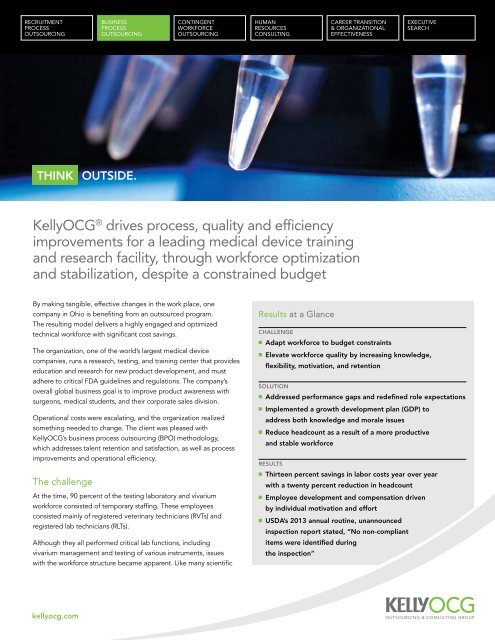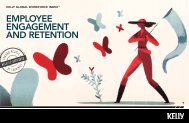View Full Case Study PDF - KellyOCG
View Full Case Study PDF - KellyOCG
View Full Case Study PDF - KellyOCG
- No tags were found...
You also want an ePaper? Increase the reach of your titles
YUMPU automatically turns print PDFs into web optimized ePapers that Google loves.
Think outside.<strong>KellyOCG</strong> ® drives process, quality and efficiencyimprovements for a leading medical device trainingand research facility, through workforce optimizationand stabilization, despite a constrained budgetBy making tangible, effective changes in the work place, onecompany in Ohio is benefiting from an outsourced program.The resulting model delivers a highly engaged and optimizedtechnical workforce with significant cost savings.The organization, one of the world’s largest medical devicecompanies, runs a research, testing, and training center that provideseducation and research for new product development, and mustadhere to critical FDA guidelines and regulations. The company’soverall global business goal is to improve product awareness withsurgeons, medical students, and their corporate sales division.Operational costs were escalating, and the organization realizedsomething needed to change. The client was pleased with<strong>KellyOCG</strong>’s business process outsourcing (BPO) methodology,which addresses talent retention and satisfaction, as well as processimprovements and operational efficiency.The challengeAt the time, 90 percent of the testing laboratory and vivariumworkforce consisted of temporary staffing. These employeesconsisted mainly of registered veterinary technicians (RVTs) andregistered lab technicians (RLTs).Although they all performed critical lab functions, includingvivarium management and testing of various instruments, issueswith the workforce structure became apparent. Like many scientificResults at a GlanceCHALLENGE■ Adapt workforce to budget constraints■ Elevate workforce quality by increasing knowledge,flexibility, motivation, and retentionSOLUTION■ Addressed performance gaps and redefined role expectations■ Implemented a growth development plan (GDP) toaddress both knowledge and morale issues■ Reduce headcount as a result of a more productiveand stable workforceRESULTS■ Thirteen percent savings in labor costs year over yearwith a twenty percent reduction in headcount■ Employee development and compensation drivenby individual motivation and effort■ USDA’s 2013 annual routine, unannouncedinspection report stated, “No non-compliantitems were identified duringthe inspection”kellyocg.com
companies today, recent budget constraints made the cost of doingbusiness—including hiring, training, retaining key employees—a major challenge.In addition, turnover was high. And because of the continuous traininginvolved, it was significantly increasing their workforce costs. Highturnover meant constant issues with the loss of trained employeesand their intellectual capital, as well as overall quality of work. Theorganization simply needed a better, more effective operating modelto manage critical populations within their workforce.The solution<strong>KellyOCG</strong> formalized a program that incorporated managementand training to help stabilize the environment, reducing turnoverand increasing productivity. This newly optimized training helpedemployees meet formalized deliverables. <strong>KellyOCG</strong> then evaluatedthis process and implemented a growth and development plan (GDP)designed to address overall employee performance and satisfaction.This enhanced the program’s overall efficiency, with increasedproductivity and decreased overall cost to the client.The GDP tracked employee education, training and progresstoward thorough staff cross training. Part of this effort includedthe implementation of a new report mechanism based on theInternational Animal Care and Use Committee. One benefit of thisreporting is a measure called distribution of time, which looks at howstaff hours are being allocated across all responsibilities. For example,one measurement demonstrated the percentage of time spent ontrue animal care versus administrative duties or downtime.<strong>KellyOCG</strong> also recently introduced new technology to supportemployee growth and development. This online performancemanagement system delivers solutions for increasing employeeengagement and stimulating organizational growth and performance.This process was instrumental in allowing the flexibility to promotefrom within, and backfill into an entry-level position. The GDPplaced all job titles on a career ladder, creating for the first time anopportunity for employees to establish lines of communication withtheir managers about career paths, growth, and barriers to retention.This ultimately led <strong>KellyOCG</strong> to recommend that all RVTs and RLTs behired on a contract basis and to make the positions the right fit for theavailable budget.The result<strong>KellyOCG</strong> delivered a multifaceted solution to the client, resulting incost savings, reduced headcount, and greater employee retention.In 2011, through process improvements and workforce stabilization,<strong>KellyOCG</strong> helped the company reduce labor costs by 13 percent.Through productivity gains in cross training and GDP implementation,headcount was reduced by 20 percent while maintaining the samevolume of work.Ultimately, the staff is more interchangeable, better trained, and moreflexible—and it shows. Not only is the client saving money, with moreefficient and precise training, they’re also enjoying a more adaptivelaboratory team.In addition, as a result of <strong>KellyOCG</strong>’s contributions to processimprovements and adherence to critical guidelines and regulations,for three years in a row the client passed USDA inspections with“no observations/non-conformities and no deficiencies noted”. Thisachievement is notable in today’s USDA age of enforcement, wheremost facilities expect to have at least one finding on their annualfacility report.The vivarium program also recently received Tri-AnnualRe-Accreditation from the Association of Assessment andAccreditation of Laboratory Animal Care (AAALAC), where thelead representative noted there would be no suggestions forimprovements (SFIs) and communicated this site ranked in the top2% of all AAALAC sites globally. In his three years on the AAALACcouncil and leading some 20 visits per year, he had neversubmitted a report without any SFIs - this was his first.For more information on how <strong>KellyOCG</strong> canhelp your business, visit kellyocg.com todaykellyocg.comAll trademarks are property of their respective owner© 2013 Kelly Services, Inc. Y0622














